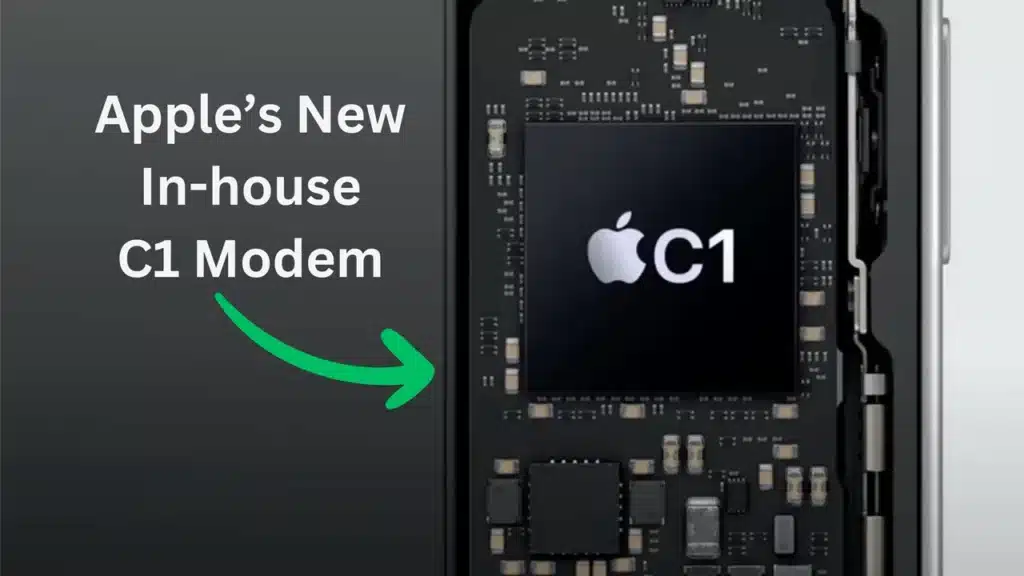The iPhone 16e launch has sparked plenty of conversation — not just for what it includes, but for what it leaves out. Missing from this model are features like MagSafe charging, the Dynamic Island, an ultrawide camera, and Wi-Fi 7. Understandably, some people have questioned whether the $599 price tag justifies these omissions.

But let’s not be too quick to dismiss the iPhone 16e. In fact, it brings several impressive upgrades compared to its predecessor, the iPhone SE 3. With a larger 6.1-inch OLED display, Face ID, a powerful A18 chip, Apple Intelligence features, and a new 48MP camera, there’s plenty to like.
However, the most intriguing addition is hidden under the hood — Apple’s brand-new C1 modem. This is a major milestone: it’s Apple’s first-ever in-house cellular modem, and it could redefine battery life in mid-range smartphones. Let’s break down what the C1 modem is, why it matters, and how it gives the iPhone 16e an edge.
What Is the Apple C1 Modem?
The C1 modem is Apple’s first attempt at a homegrown cellular modem, a project that’s been in development for years. But what exactly does this new piece of tech do?
At its core, a modem is the component in your phone responsible for connecting to cellular networks — enabling calls, texts, and mobile internet access. Until now, Apple has relied heavily on Qualcomm for its modems. With the C1, Apple is taking control of this critical hardware, integrating it more deeply into the iPhone’s design and software.

The C1 modem includes:
- Baseband Processor: The chip responsible for processing mobile signals.
- RF Transceiver: This component handles radio frequencies, supporting the sub-6GHz band of 5G.
- 7nm Transceiver: The first of its kind in a smartphone, designed to be smaller and more power-efficient.
- GPS Capabilities: Built-in location tracking and support for Apple’s satellite features.
- Optimized Software: Apple’s proprietary software tightly integrates the modem with iOS, ensuring better power management.
But why did Apple develop the C1? While reducing reliance on Qualcomm is a factor, the real motivation seems to be gaining more control over power efficiency — and that’s where things get exciting.
Also Read: Why Is The iPhone 16e So Expensive?
How the C1 Modem Boosts Battery Life
One of the biggest energy drains on any smartphone is its modem. Constantly searching for signals, handling data transfers, and maintaining connections burns through battery life quickly. Apple zeroed in on this issue with the C1, aiming not just for fast 5G performance but for minimal power consumption.
According to Apple, the C1 modem is up to 25% more energy efficient than the modem in the iPhone 15. This translates directly into better battery life.
Let’s break it down:
| iPhone Model | Streaming Video Playback |
|---|---|
| iPhone SE 3 | 10 hours |
| iPhone 16 | 18 hours |
| iPhone 16e | 21 hours |
That’s a 3-hour increase over the iPhone 16 — and more than double the battery life of the iPhone SE 3.
Real-world tests have also backed this up. In Tom’s Guide’s web-surfing battery test, the iPhone SE 3 lasted 9 hours and 5 minutes over 5G, while the iPhone 16 managed 13 hours and 19 minutes. The Pixel 8a — a key competitor — hit 11 hours and 21 minutes.
Based on these figures, the iPhone 16e could not only outlast the Pixel 8a but potentially set a new standard for mid-range phone endurance.
What’s the Catch?
While the C1 modem is a major win for battery life, there’s a key limitation: no mmWave support.
What does that mean? mmWave is a version of 5G that offers ultra-fast speeds, but it’s typically available only in select areas like stadiums, airports, and downtown city centers. Without mmWave, the iPhone 16e relies solely on sub-6GHz 5G — still fast, but not the absolute best.
For most users, this won’t be a dealbreaker. Unless you live in a mmWave-heavy city, the difference may be negligible. Still, it’s something to keep in mind, especially if you prioritize having the fastest network speeds possible.
The Bigger Picture: Why the C1 Modem Matters
The iPhone 16e is just the beginning for Apple’s in-house modems. The C1 modem signals Apple’s intent to control more of its technology stack, allowing for deeper hardware-software integration. This often leads to better efficiency, smoother performance, and more consistent updates.
Looking ahead, there’s speculation that the upcoming iPhone 17 Air — rumored to have a slimmer design and smaller battery — could also use the C1 modem. If true, this would be a strategic move, helping Apple balance design aesthetics with strong battery life.
It’s worth noting that Apple is expected to continue using Qualcomm modems in the flagship iPhone 17 and 17 Pro Max, but the C1’s debut in the 16e gives Apple the perfect testing ground for its own modem technology.
Also Read: iPhone 16e Exposed: 5 Irresistible Features — and 3 Red Flags
Conclusion: Is the iPhone 16e Worth It?
While the iPhone 16e doesn’t have all the bells and whistles of its pricier siblings, its blend of solid upgrades and cutting-edge technology makes it stand out. The star of the show is the C1 modem, pushing battery life to new heights and giving the iPhone 16e a clear advantage over many mid-range competitors.
If battery life, a sharp 48MP camera, and Apple Intelligence features matter more to you than ultrafast 5G or MagSafe charging, the iPhone 16e could be a smart buy — especially at $599.
In short: The iPhone 16e isn’t just about what’s missing — it’s about what’s next.
Are you considering the iPhone 16e, or are you holding out for the next flagship model? Let’s discuss below!
